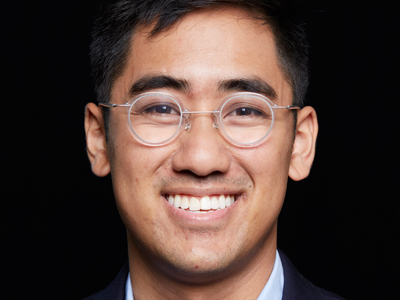
Justin Lai '14
Designer and Researcher, Office of Digital Innovation
Studio Arts major, Graphic Design emphasis
What have you been doing since graduating from LMU?
After graduating from LMU in 2014, I finished a graduate degree in public health and health care systems/delivery. I’ve spent time in academia, industry, and the public sector as a designer/researcher, working on projects including emergency hospital admissions procedures, hearing aid software design, and unemployment benefits delivery.
What is your day-to-day job like?
I’m currently a designer/researcher at Governor Gavin Newsom’s Office of Digital Innovation, where I consult for various California state agencies and departments to elevate the user experience for government services. My days often consist of mentoring and advising government in-house user experience teams, evangelizing the value of user experience and design with government leadership, and generally helping the State of California understand how to better serve its citizens.
How did your undergraduate studies prepare you for your career?
While the design and user experience profession has come a long way in the past decade, designers like myself still have to make a concerted effort to build trust and credibility in fields like health care, government, and tech. The most valuable skill I developed at LMU was learning how to thoughtfully articulate and communicate the value and logic of my work, and evangelizing the value of design for stakeholders and collaborators with non-design backgrounds.
Why did you decide to major in Studio Arts?
I was always interested in graphic design, photography, and multimedia, but wasn’t sure how it would all materialize in my professional life. I liked how the LMU STAR program gave me the opportunity to try a wide range of disciplines in my first two years, before figuring out exactly how I wanted to sharpen and hone my craft.
Tell us a little about your concentration in Studio Arts.
My Studio Arts concentration was graphic design. I fell in love with a typography class my sophomore year, and also desperately wanted to take Garland Kirkpatrick’s social design and information design classes, which were given priority to graphic design students. I was especially drawn to Professor Kirkpatrick’s firmly-held belief that designers have the ability and responsibility to solve the world’s most pressing issues, and this philosophy definitely shaped my career path to this day.
What was your favorite aspect of the STAR program?
My favorite aspect of the STAR program was the availability and accessibility of the faculty, without a doubt. The small studio arts classes at LMU gave me the opportunity to really get to know my professors, and I learned just as much from my professors in office hours and casual settings as I did in the classroom. My LMU professors Garland Kirkpatrick and Jane Brucker are probably two of my most influential mentors to this day, and I still keep in touch with them both.
Were you involved in any meaningful organizations/activities while at LMU?
I was a member of the Crimson Circle Service Organization in my four years at LMU, and also studied abroad in Bonn, Germany my Junior year.
What is your favorite memory from your time at LMU?
It’s difficult to pick one memory, although my semester study abroad was probably my most formative college experience. My drawing professor, Jane Brucker, asked if I’d like to study abroad in Bonn, Germany in the spring of my Junior year, where she was teaching some art classes and also needed a research assistant. With one year left at LMU, I still wasn’t quite sure what I should do post-graduation, and my study abroad experience in Germany ended up being the perfect opportunity to soak in the art and design world that surrounded me, reflect on my interests and personal goals, and immerse myself in a culture completely different from my own.
Do you have any advice for current STAR students?
My advice for LMU STAR students is that there’s no linear or clear path in the creative world. Find what projects interest you, identify the gaps in your knowledge, and think about how to best fill those gaps in knowledge by following your own learning and working style.